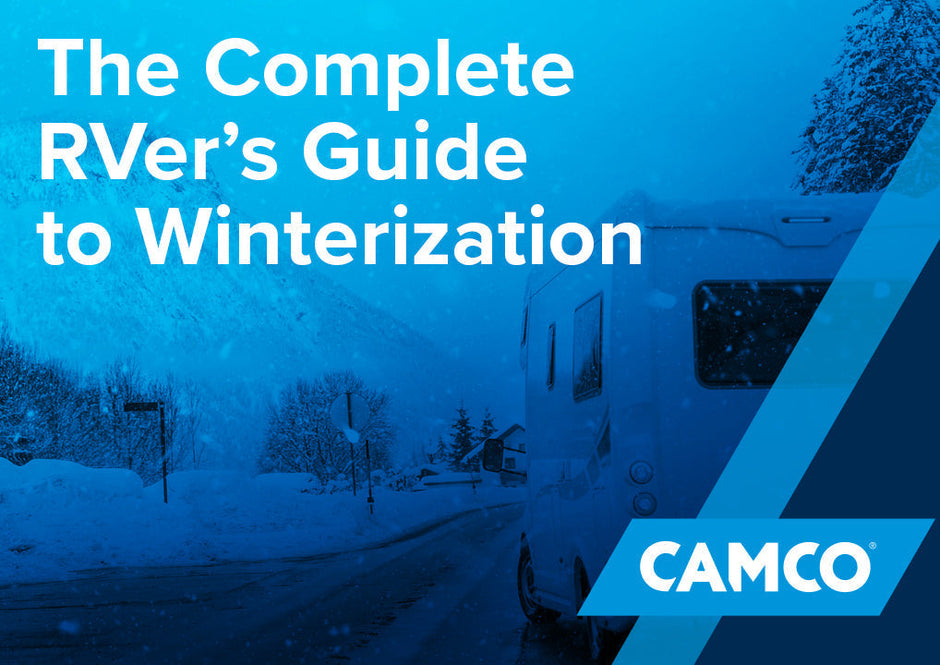Of all the jobs an RVer has to do, there’s one that separates a happy spring from a disastrous one: winterization. It’s a task that’s easy to put off, but a single hard freeze is all it takes for forgotten water in a pipe to expand and cause the kind of wallet-draining damage that can ruin your first trip of the season.
While the word itself might sound intimidating, the process is actually a straightforward job any owner can handle. With the camping season ending (for some), now is the perfect time to get it done before the first panicked cold-weather forecast arrives. This guide will walk you through the complete process, from the crucial prep work to the final details, ensuring the job is done right and keeping you worry-free all winter long.
Step One: Cleaning & Inspection

Proper winterization begins long before you ever touch a bottle of antifreeze. You would never store a car caked in mud, and the same rule applies to your RV. An RV that's clean and thoroughly checked over is less attractive to pests, prevents grime from permanently damaging surfaces, and allows you to spot potential issues before they become winter disasters.
The Final Flush
Your last trip to the dump station is your first step in winterization. Storing an RV with a dirty black tank can lead to hardened waste and stubborn sensor issues next spring. Before you head out for that final dump, you’ll want to give your black tank a powerful, deep clean.
For a job this important, you need the tank cleaning heroes: the Rhino Blaster Pro and Camco's Flexible Swivel Stik. These tools provide the mechanical scrubbing power to dislodge any stubborn waste.
- The Rhino Blaster Pro attaches directly to your sewer outlet, flushing away residue and odors with ease. Its built-in gate valve keeps water contained, so you can fill the tanks and clean debris from higher up on the tank walls.
- For a top-down approach, the Flexible Swivel Stik goes down through the toilet to power-wash the tank walls and sensors.
Of course, every hero needs a great sidekick. Using a product like TST PRO before you use the cleaning tools makes their job even more effective. Its advanced enzyme formula is designed to liquefy waste and tissue paper, cleaning tank walls and maintaining working tank sensors. Using it on your last trip or adding it a few hours before you drain the tank ensures it will be as clean as possible for its long winter rest.
The Exterior Deep Clean
Months of road grime, bug splatters, and bird droppings can permanently stain your RV’s finish if left to sit over the winter. A top-to-bottom wash is essential, and that means using the right cleaner for each job.
- Start with the roof. If your RV has a rubber roof, use a specialized product like Camco Rubber Roof Cleaner, which is formulated to safely lift tough stains from the roofing material.
- For the stubborn black streaks that run down the sides of the RV, a powerful spot treatment like the Camco Black Streak Remover is the perfect tool to dissolve them without harming your finish or decals.
When paired with a soft-bristled brush or a flow-through wash brush, it helps you tackle both jobs easily. Camco’s Rectangular Collapsible Bucket complements these tools perfectly and folds down for convenient storage when you're done.
The Roof & Seal Examination
While you’re up on the roof washing it, put on your inspector hat. Pay close attention to your plastic vent lids, which can become brittle from sun exposure. If you notice a crack, replace it with an RV Vent Lid Replacement Kit. Swapping it out now only takes about 15 minutes and prevents melting snow and ice from finding their way into your RV’s ceiling over the winter.
This is the perfect opportunity to perform a detailed visual inspection of all your seams and seals. Look for any signs of cracked or peeling sealant around roof edges, vent pipes, air vents, and windows. If you spot any compromised areas, now is the time to fix it.
- For horizontal surfaces: You'll want to use Camco’s Pro-Strength Self-Leveling Lap Sealant, which is designed to flow into crevices and create a durable, waterproof seal.
-
For vertical surfaces: You’ll want to use Camco’s Non-Leveling Sealant to ensure durable protection against the elements. A few minutes spent on this now is one of the best preventative measures you can take.
Step Two: The Great Evacuation

With your RV clean, it's time to get every last drop of water out of the plumbing. Antifreeze can't protect water it doesn't touch, so this emptying phase is the most critical part of the entire process. Don’t rush it.
- Drain the Holding Tanks: You’ve already dumped and treated your black and grey tanks, but now it’s time to drain the fresh water tank. Locate the drain valve, open it, and allow the tank to empty completely.
- Bypass & Drain the Water Heater: This is a non-negotiable step. Your water heater holds 6-10 gallons of water, and you don’t want to waste antifreeze filling a tank that doesn’t need it. While most RVs have a bypass system, they can be hard to reach or confusing to operate. To make this key step simple year after year, you can install Camco's Supreme Permanent RV Water Heater Bypass Kit. This permanent bypass kit helps you route antifreeze around your water heater, saving gallons during winterizing. Once bypassed, go outside, open the pressure relief valve, and then carefully remove the anode rod or drain plug to empty the tank. Be prepared for a rush of water!
- Open the Low-Point Drains: Underneath your RV, you’ll find the low-point drains (often red and blue). Open these and let gravity pull the remaining water out of your main supply lines. Open a few faucets inside to help air escape, allowing trapped water to flow more freely.
- Blow Out the Lines (Optional but Recommended): For the most thorough job, use compressed air to force out any stubborn pockets of water. For this, you’ll need a Camco Blow Out Plug. This simple brass fitting screws into your RV’s city water inlet and connects to an air compressor.
*Important Safety Tip: You must use an air pressure regulator on your compressor. Set it to a low pressure—never exceed 50 PSI. Higher pressure can damage your plumbing. With the air flowing, go inside and open each faucet (hot and cold) one by one until it’s just spitting air. Don’t forget the toilet and showers.
Step Three: The Antifreeze Insurance Policy

With the system empty, it's time for your insurance policy: filling the lines with an RV antifreeze. Be sure to choose a temperature rating, like -50°F or -100°F, that’s appropriate for your climate. There are two simple ways to get the antifreeze into your plumbing, and Camco has a kit for either approach:
- The Convenient Method: If your RV doesn’t already have one, install a Camco Pump Converter Winterizing Kit. Each year, you can then use your onboard pump to draw antifreeze directly from the jug—the fastest and easiest method.
- The Universal Method: Use the Camco Hand Pump Kit. This simple pump connects to your city water inlet and lets you manually pump antifreeze through the lines with no permanent installation required.
Whichever kit you use, the goal is the same: go to every faucet (hot and cold), the toilet, and any showers (inside and out), and run them one by one until you see a steady flow of colored antifreeze. This confirms your entire system is protected.
Step Four: The Finishing Touches

The main lines are now protected, but a few final details will make the job complete.
- Protect the P-Traps: Pour about a cup of antifreeze down each drain (sinks & shower) to fill the P-trap. This prevents any water in the trap from freezing and cracking the pipe.
- Check Your Appliances: If you have an ice maker or washing machine, check the manual for specific winterization instructions.
- Control Interior Moisture: An RV sealed for the winter creates the perfect environment for humidity to build up, which can result in musty odors and mildew growth. Place a Moisture Absorber Bucket inside your RV to silently combat humidity all winter long. It efficiently pulls excess moisture from the air, helping to keep your interior fresh, dry, and free from musty odors.
-
Think Beyond the Pipes: Take those final steps to safeguard your investment. Use rodent deterrents to keep pests at bay, cover your tires to shield them from harmful UV rays, and either remove your batteries for storage on a tender or make sure your RV’s battery disconnect switch is turned off.
Peace of Mind for the Winter
Winterizing your RV is more than just a checklist—it’s about preparing your home on wheels for the months ahead. Starting with a clean, inspected RV and finishing with thoughtful protective measures, you’re not just maintaining your vehicle—you’re preserving your investment and the adventures it holds.
There's a deep satisfaction that comes from a job well done. As you close the door on your RV for the season, you can rest assured it’s safe, secure, and ready to hit the road when spring’s first warm breeze signals it’s time for new journeys.
Happy prepping!







